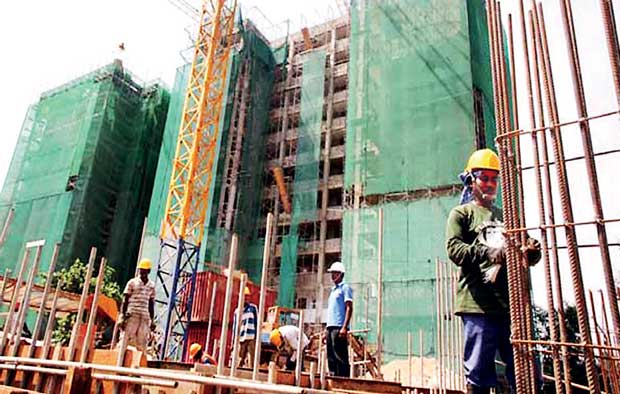26 Jul 2017 - {{hitsCtrl.values.hits}}

Today, the growth of Sri Lanka’s construction industry has become a hot topic. The housing construction sector in particular has seen rapid growth due to the rise in housing demand as well as government incentives for new housing projects.
As office space continues to plummet, skyscrapers and high-rises have begun to mushroom. With the country-wide expansion of infrastructural development which includes the massive US$40 billion Megapolis development plan, the construction industry is heading for a revolutionary change.
In the construction industry, it is imperative to satisfy several key factors such as incorporating high quality raw material, cutting edge technology, skilled labour and a proper regulatory body, to constantly maintain highest quality and standard. Certain factions, engaged in importing and selling substandard cement, have ruined the faith placed by consumers. This has been further affected by the flaws found in standardization process of cement.

Cement, sand, metals and steel are key materials used in the construction sector. Even though the construction sector utilize several other materials, these four elements - cement, sand, metals and steel that are used for producing concrete solely ensure the strength and durability of a building.
Cement
Out of the above mentioned elements, cement is the only material produced inside a factory under special quality controlled means. Only a cement manufacturing company, who has a 100 percent local manufacturing facility with fully integrated plant, can maintain consistent quality and standard throughout the process of cement production, this consistent quality cement will lay a strong footing to local construction industry. If standardization techniques can be further developed parallel to the growth of the local construction sector, the consumers will be able to buy the finest quality cement. It is essential to spread awareness among those involved in the construction sector and the general public of the importance of using high quality cement instead of importing and distributing low priced substandard cement.
Sand
Finding high quality pristine sand is one of the biggest challenges faced by the industry. This type of sand is not only rare but is also priced highly. One of the main reasons for the high price is the lack of resources as opposed to the escalating demands. Moreover, after considering the environmental impact, the government has imposed strict laws on sand mining.
Due to this reason, certain individuals have focused on mining inland dunes. However, sand excavated from inland dunes contains higher percentage of cohesive sediment (mud) which exceeds the recommended limits, posing difficulty in controlling cracks and ruptures that may appear in structures made of such concrete.
Under such circumstances, it is imperative for both government and the private sector to intervene into the matter and prevent an imminent collapse in the construction industry. As an alternative, sand can be pumped from the deep sea and can be delivered after controlling salt levels. Currently the Sri Lanka Land Reclamation and Development Corporation has taken the initiative on this regard, and with the collaborative support from the private sector, it would be possible to meet the rising demands.
Gravel and Sand
Extraction of gravel and sand poses great difficulty for the construction sector. Even though geographical mapping take place to certain extent, the problem remains unaddressed.
Metals
As the construction industry expands rapidly, a metal shortage will be imminent. Furthermore, high quality metal with standard sizes will become a rarity as well.
With the boom in construction industry, demolition of old constructions takes place more frequently. It is important to devise a plan to recycle and reuse such waste debris following a demolition. For example, the Galle Municipal Council has successfully up cycled debris waste and incorporated them in their constructions for more than 10 years. The Galle Municipal Council has set an ideal example to all other institutions in the country.
Reinforcement
The increasing demand for reinforcement causes a high competition in the market, which leads manufacturers to sell their products at economic rates. Industrial experts have warned that constructions that incorporate substandard reinforcement are likely to collapse in due course.
New Technology
Sri Lanka is hesitant about going beyond traditional construction boundaries, and the situation has critically deterred the progress of all sectors including financial management, technology and project management. In order to overcome this situation, the Construction Industry Development Authority should adopt stringent supervision, and uplift the industries with the collaboration of Contractors’ Union. In addition, it is also imperative to apply modern technology to alleviate problems related to raw material.
Furthermore, local contractors should be given an opportunity to collaborate with international firms when implementing foreign funded mega projects. Government’s intervention is critical in such instances, which would help local contractors to enhance their knowledge, capabilities and skills.
Skilled Labour
Currently Sri Lanka is experiencing a shortage in skilled labour. Due to this reason, local contractors find difficulty in meeting project deadlines. According to the Central Bank reports, total value of construction contracts amount to Rs.15 billion by 1995, while this value has increased to Rs.200 billion by 2015, denoting a staggering increment of 1233 percent. However, in contrast to this hike, the skilled labour has only increased by a mere eight percent. To overcome this issue, vocational training subjects should be included in the school curriculum from a lower grade, and only teachers with special training should be assigned for the relevant subjects.
Even though there are majority of unemployed youth in the country with the potential to draw a higher income in the construction sector, it would be difficult to incorporate the youth without alleviating deep rooted misconceptions regarding the construction industry.
The problem can be addressed to a great extent if the public and private sectors implement a joint programme to address the issue on a broader perspective, present the recruits with new titles, uniforms, identity cards and offer bank loans while creating an employee-friendly working environment.
Regulation of constructions
Construction Industry Development Authority (CIDA) is responsible for regulating constructions within Sri Lanka. The institution is also involved in grading and registering contractors, training labourers and determining limitations of raw materials related to the construction industry. However, in its effort to fulfill these responsibilities, the CIDA is observed to have been facing certain issues. As per the 2014 clause 33 of the Construction Development Act, CIDA has been vested with the powers to properly regulate the construction industry. However, the institute has not been able to perform as expected due to the lack of funds exclusively specified in the same Act.
Once the shortcomings are resolved, regulatory measures can commence. And the National Construction Association of Sri Lanka (NCASL) is ready to extend its fullest support at all times towards any task that supports the development of the construction industry.
07 Jan 2025 3 hours ago
07 Jan 2025 3 hours ago
07 Jan 2025 4 hours ago
07 Jan 2025 6 hours ago
07 Jan 2025 6 hours ago